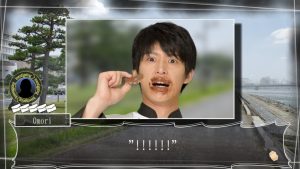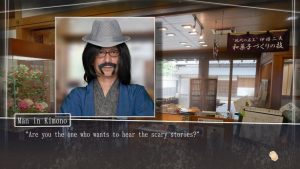Visual novels are a unique niche of games that are widely popular around the world. While each game is different, visual novels are generally video games that are a mix between reading a manga and playing an RPG. Players interact with the story/world and make choices that affect the outcome of the game. Typically, these types of games have multiple endings that can be achieved through different playthroughs. Root Letter: Last Answer is one of the newer games in this gaming niche, and there’s a lot to say about it.
Root Letter: Last Answer is a revamped edition of the original Root Letter visual novel. Both games share the same story: You are a young man in his early thirties trying to track down your high school penpal. You spend the entire game tracking down the enigmatic Aya Fumino, learning various truths and speculations from a myriad of people. You go to her hometown in the Shimane prefecture in Japan and start questioning the friends she wrote about in her letters. The only thing is, she appears to either be dead or to have never existed at all.
While there is a lot to be said about this new version of Root Letter (and Root Letter in general), I will focus on the biggest impressions I was left with, while sharing my overall thoughts. Be aware that there will be minor spoilers in my review. There will be bigger spoilers later on, but I will safely mark when those come.
Let’s start with the positives.
What I liked about Root Letter: Last Answer
Root Letter: Last Answer took the visual novel genre in a new direction. I played the game on the Nintendo Switch, which was a fun change of pace for me, as I typically play on the PS4. I enjoyed the unique gameplay, as it deviated from many other visual novel games in the genre. For example, in many visual novels, you are given specific choices and spend a lot of time either making said choices or reading. Root Letter takes things a step further.
While every visual novel comes with a lot of reading and choices, Root Letter gives players the autonomy to choose what they think they should do next and even explore the world a little. There are a variety of options you can choose between when exploring the game and figuring out what to do at any given time.
The game starts out with you discovering a mysterious 11th letter you don’t remember receiving, where Aya tells you she killed someone. You haven’t heard from her since high school, and this mysterious letter piques your interest even more. What was she talking about? And why don’t you remember receiving it?
You’re from Tokyo, so you decide to take a trip and uncover some much-needed truths. So, you fly to Matsue in the Shimane prefecture and start unraveling the mystery. What started as wanting to find Aya and talk to her again, asking a few questions and catching up, turns into a murder mystery and/or ghost hunt. Everyone you talk to either denies the existence of Aya Fumino or tells you she died twenty-five years ago.
One of the more interesting parts of Root Letter is that the possible endings are wildly diverse. While there is one “true ending” (which is the one I prefer), there are riveting alternate endings that follow some of the paranormal, creepier threads in the story. But more on that later.
Again, I liked the gameplay in this visual novel. I was pleasantly surprised that playing this game wasn’t just reading and making minor choices. You have a lot of options and even have to figure out what to do and where to go at times. For example, when you reach a sort of dead-end, you have to decide who to talk to, where to go next, or if you should investigate one of the areas. There is a special “check” tool where you scan the area around you for things that may be of significance. A lot of the time, you can’t progress in the story until you “check” the right items or locations, which I thought was clever.
I also really loved the premise. It was cool and creepy, while still being light-hearted and fun. I loved the nostalgic anime feel and the intrigue. The character you play is pretty funny and has some good lines, too.
What I didn’t like about Root Letter: Last Answer
While I overall really enjoyed this game, I did not like the live-action choice of this revamped edition of Root Letter. I actually played a large chunk of the game on the live-action mode without realizing there was an animated option. The live-action version is very cheesy and hard to take seriously. I found myself wondering multiple times if they were trying to be funny and ridiculous or not. I still don’t know. However, if they were trying to be funny, they succeeded.
The following images are some of the evidence behind what I’m talking about:



Note: This is in no way a slant on the actors in the live-action iteration (or the script or anything like that). These are just my thoughts on the execution of this style of the game.
I wasn’t sure what was up with the cheap wigs and comical facial expressions. I couldn’t figure out if it was supposed to come across as comical or not. Whatever the case may be, I enjoyed the game a lot more when I switched to the animated version. Others may have liked the live-action version, but I found the more serious, anime-styled version of the game more appealing. Although, I did like how tasty the live-action food looked. And I liked seeing the real-life locations within Japan. Other than that, the animated version was far superior.
The other thing I didn’t like (and found really annoying) was the “Max Mode” (as pictured below). This is essentially your character going “to the max” and basically just being super intense. You have to click “A” when you get to the choice you want on the meter. Sometimes it takes multiple attempts to get the answer you’re supposed to choose for the story to progress. I thought this whole thing was unnecessary (and also kind of cheesy).

Lastly, I didn’t like that you couldn’t reach the “true ending” until after completing the game at least once. I was frustrated that I spent hours upon hours on the game only to reach an anti-climactic, unsatisfying ending. I know this sort of thing happens in visual novels until you get to the right ending, it stung a little bit more in this one.
However, when I watched a video of the “true ending,” I was a lot happier (though I wished I had been able to experience it myself through my own playthrough).
5 Different Endings
If you don’t care about reading about the different endings of this game, feel free to keep reading, if not, know that there are SPOILERS AHEAD and that you can skip to the END OF SPOILERS sub-header below if you wish to finish reading the review without spoiling any of the endings.
I, personally, only played through the game once and got the “crossing paths” ending. I have since watched and read about the other endings. It is also worth noting that each ending is autonomous from the others and offers complete alternative timelines for the story as a whole. So, rather than the endings themselves being different, the endings reveal how each alternate timeline is different.
The following are the different endings players can reach upon various play-throughs:
Crossing Paths: This is the most anti-climactic ending, and it’s the one I got when I finished the game. You basically end up just barely missing the real-life Aya when your trail reaches her place of work: at a senior home, caring for Mr. Fumino. You find out her real name is Shiori and that you left an impression on her, but that you’ll never meet. You make peace with this fact and then move on with your life. Worst ending ever.
The Bond of Marriage (which isn’t unlocked until the first playthrough is complete): This is the “true ending” and definitely the most satisfying. It also makes the most sense. You finally find Aya (whose real name, as mentioned above, is Shiori) and get to her in time. You find out her true identity and fall in love with the real her. If you have Root Letter: Last Answer, you also get to play a bonus segment where you propose and get married.
The Princess of Himegamori Forest: This ending/story is the most twisted of all the rest. In this timeline/dimension, Aya and Shiori are secretly sisters. Aya was dangerous and threatened to kill her younger sister, so Shiori was sent to live with a relative instead. So, when Aya dies, Shiori plays her part until getting possessed by Aya herself. Aya is then living her own demented reality in Shiori’s body, and it is implied that she kills her father in the end as well.
The Cursed Letter: This ending follows the storyline of the legend you/your character was told about by the local supernatural guru in town about how after the true Aya Fumino died, a person in the class each year had to pretend to be Aya and connect with a penpal so that Aya would have a friend. This was supposedly to ward off Aya killing one of the students each year. The only catch is that if the penpal finds out, everyone would die. Well, in this ending, this was the truth, so once you figure it out, you (and everyone else) die.
A Government Plot (this also isn’t unlocked until after your first playthrough): This ending is wild. One of the theories earlier on was that there were aliens involved in the Aya case. You frequent the UFO headquarters and talk with “Fatty” about suspicious alien activity involving Aya. In this ending, Shiori is revealed to be an alien and you are sent to a mental hospital for the rest of your days. Pretty odd and dark.
Here is a helpful website offering gamers directions on how to reach any one of these endings.
END OF SPOILERS
Conclusion
Overall, the game was definitely worth playing, in my opinion. I thought it was really fun and unique, and I think reaching some of the different endings would add more fun and intrigue to the mix. However, as I mentioned earlier, I didn’t like that I’d have to play it more than once to reach the “true ending,” which offers the most satisfaction (at least to someone like me, who wanted my character to succeed in his quest and live a happy life). However, I’m glad that this ending exists and is accessible. It is indeed a satisfying conclusion to the events of the game (after having watched it myself).
In addition to the live-action option only accessible in this version of the game, Root Letter: Last Answer also comes with bonus scenes/parts to play, which take place after the endings have been reached. This version also comes with a cool artbook as well. However, that’s pretty much all that sets it apart from the original. That, and that it was made available for the Nintendo Switch.
So, if you want to play this game but don’t care about the live-action version or the additional bonuses at the end of the game, or the visual art book, just stick with the original version. However, if playing on the Switch is preferable to you, and these extras interest you, you should definitely get this version of the game. You still get the option to play in the original style if you purchase Root Letter: Last Answer, so you really can’t go wrong by choosing this one if you are trying to decide between the two.
Overall, I enjoyed my experience playing this game and hope for many more like it.
What did you think about Root Letter? Let us know in the comments below or on Twitter!







[…] style, the detailed food presentations create a feast for the eyes. Players can explore the vibrant Shimane prefecture setting while uncovering local […]